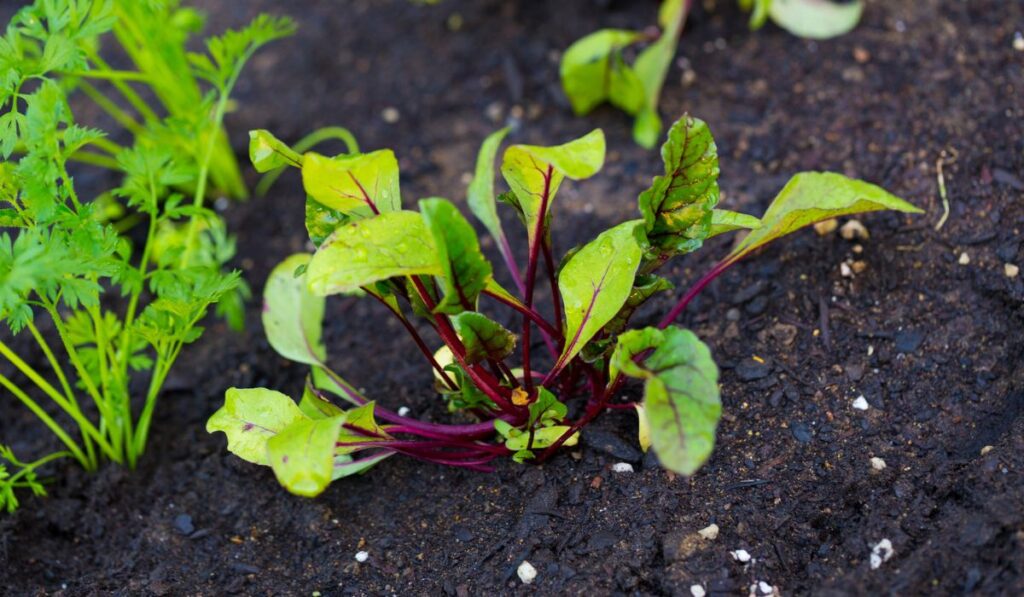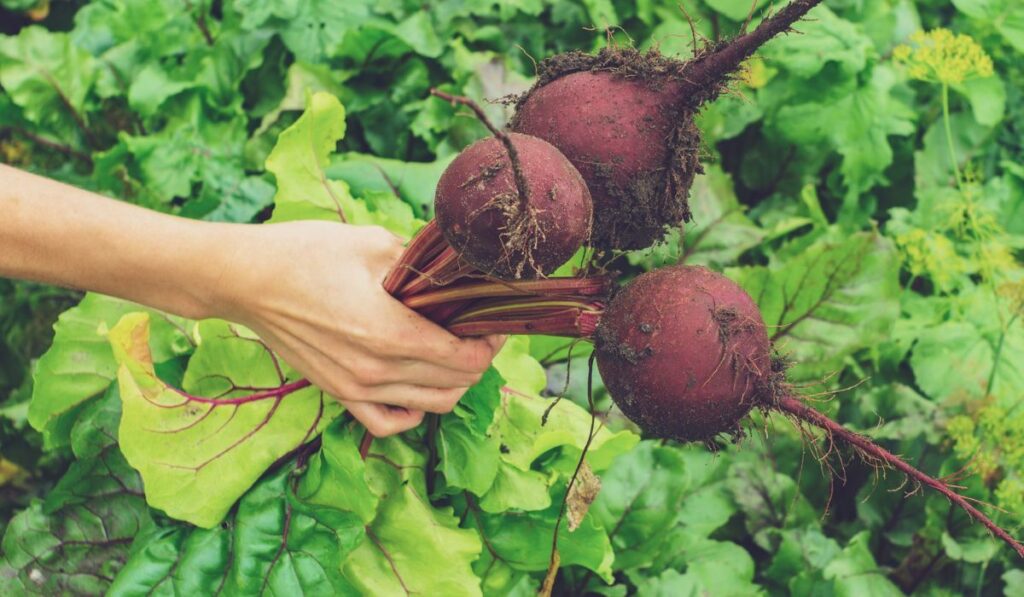Beets are delicious vegetables that are easy to grow. These plants are cool-season, grow quickly, can be grown almost anywhere, and are rarely disturbed by pests and diseases. But, of course, gardeners must carry out a few essential steps to ensure the plant matures properly.
The best time to plant beets is between August and October when the temperature isn’t too hot. Beets take 50 to 70 days to grow after planting. Beets also don’t need much sun and can be grown with other plants, making them a very flexible addition to your vegetable garden.
You can also consume multiple parts of the plant. So take advantage of the quick maturity window by planting the seeds during spring, late summer, or fall. Read on to find out how you can reap a bountiful harvest.
How Late Can You Plant Beets?

Beet seeds (on Amazon) grow best in cool temperatures. So, you can plant them at the latest during late August through October to harvest during fall or winter. These half-hardy vegetables also grow well earlier in the year, especially in the spring.
High temperatures do not favor these plants. Temperatures above 80°F cause beets to develop a bitter taste and lead to the roots becoming woody. That is why you should plant beets as soon as possible during spring to enjoy the harvest before the temperatures rise too high.
After that, you can plant beets again in late summer for harvest in late fall and winter.
How do You Plant Beet Seeds?
Beets flourish in well-drained, fertile soil but will grow in soils with average to low fertility. These plants also prefer a soil pH ranging from 6.0 to 7.0. Wait until the soil is dry enough to dig, then prepare the plant bed by digging five to eight inches deep into the ground with a trowel.
Ensure you turn the soil over to loosen it and remove any debris that may affect the growth of the seeds. Afterward, apply fertilizer to the soil and mix it all. The recommended depth for planting beet seeds is about half an inch deep into the soil.
However, as the season progresses, plant beets deeper into one-inch holes. Do not forget to plant them 1 inch apart in every direction.
Do Beets Need Full Sun?
Beets don’t need full sun—Full sun refers to six hours of sunlight daily. These plants, however, don’t require that much sunlight. They only need four to five hours of direct sunlight per day. Although beets tolerate shade well, you still need to provide them with some sunlight.
However, if you live in temperate regions, you can give the plant a full day of sun. Sunlight is beneficial as long as the plant’s leaves don’t get burned.
What is a Good Companion Plant for Beets?
Beets are easy plants to grow and can complement various vegetables in your garden. However, you don’t want to plant crops that compete with one another. The ultimate goal for every gardener is to ensure high-quality plants.
So, it’s essential to plant your vegetables where they’ll grow best. That being said, let’s look at seven plants that serve as excellent companions for beets.
1. Radishes
Beets tend to toughen when growing in dense soil. That’s why you should plant radishes near beets. Radishes help loosen the dirt, ensuring the beets are in top condition.
2. Onions
Onions can serve as a natural pest deterrent, repelling beetles, aphids, and even bigger pests like rabbits.
3. Cabbages
Cabbages make an excellent companion for beets. Plant beets alongside this vegetable to enrich the soil and improve the quality of the produce.
4. Lettuce
Lettuce has a shallow root system, making them an excellent beet companion. This vegetable will fill the gaps in your garden bed without competing for nutrients with the beet.
5. Aromatic herbs
Aromatic herbs like mint, thyme, rosemary, mint, and catnip are good beet companions because their scent repels pests.
6. Oats
Planting beets close to oats decreases beetroot maggot damage. Consider under-sowing your beets with oats and green manure for added protection from maggot.
7. Broccoli
Broccoli benefits your beet plants by adding vital nutrients to the soil, which helps the beets grow and develop into strong, mature plants.
Do You Need to Soak Beet Seeds Before Planting?
Beets can grow slowly during any planting season. However, we recommend soaking beet seeds no longer than 12 hours before planting to expedite the plant’s growth. For better results, you could soak the seeds in a mixture of warm water with a minimal amount of liquid kelp.
How to Grow Beets
Growing beets is relatively straightforward. However, the plant requires regular monitoring for the best quality crop.
- As the greens grow four to six inches tall, thin the beet plant and ensure they are roughly three inches apart.
- Thinning allows the plant’s roots to mature to their full size. Remember, when thinning, avoid pulling the plants to avoid disturbing the edible beet’s roots. Instead, snip the greens off.
- Afterward, mulch, then water them generously weekly. Beets require a lot of moisture to grow well.
- Weed as much as you deem fit. However, be gentle when uprooting weeds near young beet plants. Beetroots are shallow and can easily get disturbed so take your time when weeding.
Additionally, row covers can help keep pests away from beet leaves. It is rarely necessary to add additional fertilizer. However, if you decide to fertilize, apply nitrogen sparsely; too much nitrogen results in small root bulbs.
How Long do Beets Take to Grow?
Beets mature between 50 to 70 days after planting. These plants are typically ready for harvest once they’re three to four inches tall. The greens are at their tenderest when they’re about five inches long.
You can eat these leaves raw or chop them up and cook them. Moreover, once the beet’s diameter spans roughly two inches, the plant is fully grown.
Do Beets Need Lots of Water?
Beets love moisture; however, that doesn’t mean they love being soaked. Instead, these plants prefer consistent light to moderate watering sessions. It is critical to avoid soaking the soil daily, as this can backfire and cause rot and disease issues in the beet’s green and bulbs.
Checking the Water
If you want to check if you need to water your beets, stick your finger into the soil near your beet crop with your fingers. Don’t water if the ground feels slightly moist, about three inches deep. However, you’ll need to soak the plant if the soil feels dry.
When watering, take care not to wash the surrounding soil around the beet’s root. Exposed roots are more susceptible to weather conditions and pests.
Use Mulch
Furthermore, you can apply mulch around the plant to guarantee that the soil retains moisture. As an additional benefit, mulch prevents soil erosion. You can make mulch from leaves or straw. Adding mulch is best when the beet’s greens are a few inches tall.
How do You Fertilize Beets?
We recommend fertilizing the soil before planting beets. Consider compost and granular fertilizers to fertilize beets. Apply any fertilizers into the soil and water the planting area. But choose one containing more potassium and phosphate with less nitrogen—for example, a 5-10-10 fertilizer.
Nitrogen stimulates the growth of foliage in plants. On the other hand, potassium and phosphate boost root development, and since beets are root vegetables, they’ll need more phosphate and potassium.
How to Harvest Beets

Beets are delicious veggies with edible roots and leaves. You’ll want to harvest the entire plant right around the maturity date—typically 50 to 70 days post-planting—to get the biggest roots. If you leave the plant in the soil past the specified maturity date, the root will grow bigger; however, bigger isn’t always better.
The Roots
The bigger beets grow, the harder they become to consume. On the other hand, if you are satisfied with the root’s size, you can harvest it before its maturity date. To harvest the roots of the beet, gently pull it out from the plant bed.
The Leaves
You can also harvest beet greens while they’re growing. Alternatively, you can harvest longer, more mature leaves and add them to your fall dishes. Take it easy cutting up these leaves; you don’t want to harvest all the leaves.
Without these leaves, the plants will have stunted growth, and nobody wants tiny roots after waiting for two months. Furthermore, ensure you leave a minimum of three fully developed leaves on the plant and avoid removing the smaller leaves in the center.
How to Store Beets
If you’ve harvested more beet roots and leaves than you can currently eat, you’ll need to store them to keep their freshness. If you plan on eating these veggies within two or three days, you can store them in an airtight bag and place them in the fridge.
Beetroots last much longer than leaves with greens, withering in about a week. So, if you want to add the fleshy leaves to your fall salad recipe, use them quickly. On the other hand,
Beetroots can last for weeks, depending on how you store them. The roots keep well in cool and dry places like a root cellar. Beetroots can also last for a few weeks in a fridge. Ensure the beetroot pack is airtight to prevent moisture from entering the pack and ruining the root.
Conclusion
As you can probably tell by now, growing beets requires short, simple steps. What’s important is you need to follow these steps regularly and appropriately. Also, remember to plant beets before the weather gets too hot and grow in well-drained soil.
In addition, don’t forget to weed and apply mulch as necessary. Following these steps will have you harvesting high-quality beets in no time.
